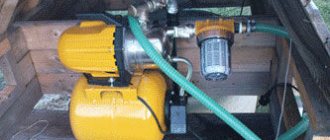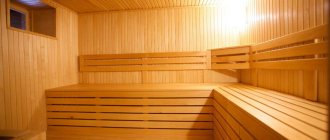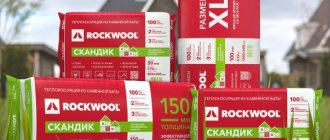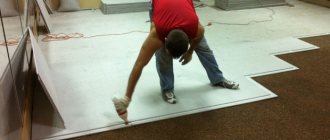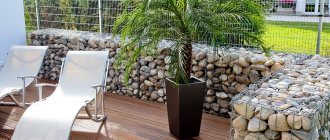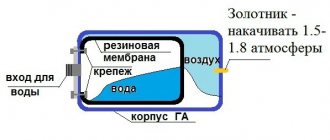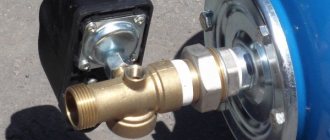Thanks to modern equipment, a private homeowner has the opportunity to set up an autonomous water supply system at will. For seasonal living in a country house or dacha, a pumping station without a hydraulic accumulator is quite suitable, although this solution is used less and less due to its impracticality.
Let's consider the principle of operation, the pros and cons of a system that operates directly from a well or well to water collection points. We will evaluate the feasibility of such a solution, and also present options for organizing water supply without a hydraulic accumulator.
Is it advisable to abandon the hydraulic accumulator?
When designing a water supply system for a house, it is necessary to take into account factors such as the number of consumers, the volume of pumped liquid, and the resource of a well or borehole. If water is required on an ongoing basis and in large quantities, then you simply cannot do without a hydraulic accumulator.
A pumping station with a hydraulic tank ensures a continuous supply of water to the house, and if a power outage suddenly occurs, the supply of liquid is enough to finish your business. The volume of the tank is selected based on needs.
The average volume for domestic use is 25-50 liters, but for frequent use it is better to immediately purchase a 100-200 liter tank or include a storage tank as an addition to the circuit.
The hydraulic accumulator performs several important functions: it stabilizes the water pressure in the system, protects equipment from water hammer, and increases the service life of the pump.
The water supply system can operate without a hydraulic accumulator. In essence, it is a pump connected by a pipeline to water collection points. The main disadvantage of such a system is the rapid wear of pumping equipment.
In a system with a hydraulic tank, the pump is turned on only when necessary, but here it will turn on every time someone opens a water tap or wants to water the flowers. Due to frequent activation, the engine fails faster, and the pump has to be repaired or replaced more often than usual.
Connection diagram for a pumping station without a hydraulic tank. A surface pump is installed in the basement, water is supplied through a suction pipeline lowered into a well (well) (+)
However, manufacturers have not abandoned models without a hydraulic tank, because they are in demand. Most often they are of interest to owners of summer cottages who use the water supply system only in the summer - for recreation, growing vegetables or flowers.
Let's consider situations in which you can get by with one pump, without a hydraulic accumulator:
Image gallery
Photo from
Watering lawns or flower beds
Caring for garden beds
Drip irrigation system
Summer house for seasonal stay
Thus, if there is no need for a large amount of water, which must be supplied stably, constantly and have a reserve, you can get by with an ordinary automatic pump. In other cases, a hydraulic accumulator is required.
Install pressure reducer
Set the pressure reducer to 1.5-2 bar
This device has several types of design (piston or membrane). In this case we will talk about a piston type design. This is the so-called additional pressure limiting element in the system after the pump station relay. Typically, a pressure of 4 bar is also considered high. You can set 1-1.5 bar on the gearbox, which will ensure stable operation of the entire system as a whole.
For complete clarity, we will repeat it again. A station pressure switch eliminates general overload from fixed networks. The pressure reducer provides comfortable conditions for using water supply networks in the house.
An inquisitive reader may have a technically correct question: why is it necessary to use two pressure relief options. You can safely set, for example, 1.5 on the pumping station relay. The whole secret lies in the operating parameters of the hydraulic accumulator. To fill it with water, it is necessary to create an increased pressure of more than 4 bar. Therefore, the entire water supply system is schematically divided into two zones, high and low pressure.
First, there is a connection from the pump to the expansion tank (high pressure zone), then from the tank through the reducer to the central water supply (low pressure zone). If you really want, you can assemble the entire structure with your own hands. The main thing is compliance with the calculations and the procedure for the established actions. Installation on a well is as realistic as connecting to a centralized water supply.
For complete clarity, when summing up, it is necessary to note the following options necessary for the stable operation of the entire water supply. Namely:
- Use filter elements.
- Understand the operation of the pumping station and relay according to the instructions.
- Be sure to use hydraulic accumulators.
- Use a pressure reducer.
As a rule, such equipment can be quite expensive. But if you calculate in advance the possible options for classic, outdated water supply schemes, the difference is obvious. Firstly, the comfort of use is immediately impaired. The station is constantly working (noise, hum of the electric motor). The pressure in the network is either too low, or vice versa, it breaks all connections and internal parts of the taps.
Without filter elements, the moving parts of the pump, working areas of regulators, and valves become clogged. And if the sampling is carried out from a well, then cleaning means are simply necessary. A storage tank would be useful in case there is no water for some time. As a result, when carrying out preliminary calculations, it becomes obvious that installing a pumping station according to the presented scheme is an excellent option for long-term use with minimal maintenance costs.
Operating principle of a system without a hydraulic tank
Equipment pumping water works the same way: it takes liquid from a source - a well, a well - and pumps it into the house, to water collection points. The pump can be either submersible or surface pump.
The role of connecting lines is performed by pipelines made of polypropylene pipes or flexible hoses. In the same way, water is supplied to the bathhouse, garage, summer kitchen, and swimming pool.
So that water can be used in autumn or early spring, it is recommended to insulate the well and bury the pipes to a depth of 70-80 cm - then the liquid will not freeze even during frosts
The difference concerns the use of additional devices, such as a hydraulic accumulator, pressure switch, etc. Installing pumping equipment without means of control and adjustment is extremely dangerous - primarily for the equipment itself.
The simplest example of equipment for providing dacha residents with water in the summer is the AL-KO garden pump. You can use it to water plants, organize a shower, or fill a pool with water.
If a large amount of water or a more stable supply is needed, another important element is included in the scheme - a storage tank. First, the water flows into it, and only then to consumers.
When using household pumps, the liquid volume is usually from 2 to 6 m³/h. This amount is usually enough if the station is connected to a well or borehole and serves a country house.
When choosing a unit, it should be taken into account that the absence of a hydraulic tank accelerates the wear of parts, so the equipment must be durable - with a steel or cast iron body coated with anti-corrosion paint.
The pump functions are controlled using a pressure switch, which is responsible for regulating the pressure. For control, the easiest way is to install a pressure gauge, which is usually equipped with automatic pumping stations.
In the absence of a hydraulic accumulator, the pressure switch is connected directly to the pumping station or integrated together with a dry-running relay into the pipeline
In addition to equipment for pumping water, you will need an electrical cable, a connection point to the network and grounding terminals. If the ready-made solution does not satisfy your needs, the station parts can be purchased separately and then assembled at the installation site. The main condition is the compliance of the system elements with characteristics.
Choice: built-in or external?
Depending on the installation location, there are remote and built-in ejectors. There is no big difference in the design features of these devices, but the location of the ejector still affects in some way both the installation of the pumping station and its operation.
So, built-in ejectors are usually placed inside the pump housing or in close proximity to it. As a result, the ejector takes up minimal space and does not have to be installed separately; it is enough to carry out the usual installation of the pumping station or the pump itself.
In addition, the ejector located in the housing is reliably protected from contamination. Vacuum and reverse water intake are carried out directly in the pump housing. There is no need to install additional filters to protect the ejector from clogging with sludge particles or sand.
A remote ejector for a pumping station is more difficult to install than an internal model, but this option creates a much less noise effect
However, it should be remembered that this model demonstrates maximum efficiency at shallow depths, up to 10 meters. Pumps with a built-in ejector are designed for such relatively shallow sources; their advantage is that they provide excellent incoming water pressure.
As a result, these characteristics are sufficient to use water not only for domestic needs, but also for irrigation or other economic operations. Another problem is the increased noise level, since the vibration of the operating pump is added to the sound effect of water passing through the ejector.
If you decide to install a pump with a built-in ejector, you will have to take special care of sound insulation. It is recommended to install pumps or pumping stations with a built-in ejector outside the house, for example, in a separate building or in a well caisson.
The electric motor for a pump with an ejector must be more powerful than for a similar model without an ejector.
An external or external ejector is installed at a certain distance from the pump, and this distance can be quite significant: 20-40 meters, some experts even consider 50 meters acceptable. Thus, a remote ejector can be placed directly in a water source, for example, in a well.
The external ejector does not so much increase the pump’s performance as it is designed to increase the depth of water intake from the source, which can reach 20-45 m
Of course, the noise from the operation of an ejector installed deep underground will no longer disturb the residents of the house. However, this type of device must be connected to the system using a recirculation pipe through which the water will return to the ejector.
The greater the installation depth of the device, the longer the pipe will have to be lowered into the well or well.
It is better to provide for the presence of another pipe in the well at the design stage of the device. Connecting a remote ejector also involves installing a separate storage tank from which water will be drawn for recirculation.
Such a tank allows you to reduce the load on the surface pump, saving some energy. It is worth noting that the operating efficiency of the external ejector is somewhat lower than that of models built into the pump, however, the ability to significantly increase the intake depth makes one come to terms with this drawback.
When using an external ejector, there is no need to place the pumping station directly near the water source. It can be installed in the basement of a residential building. The distance to the source can vary within 20-40 meters; this will not affect the performance of the pumping equipment.
Water supply without accumulator
If you exclude the hydraulic accumulator from the water supply scheme, then two options are possible:
- using a pump to supply water directly to water collection points;
- connecting a storage tank.
Both options are actively used, but the first is optimal for irrigation systems with a small volume of liquid, and the second is most appropriate when you need to provide water to a shower, kitchen faucet - that is, consumers inside the house.
Option #1 - connecting the pump directly
There are many interesting solutions, but the most practical and economical are automated irrigation systems. They work only during periods when there is no rain, and are installed wherever regular watering is necessary - in the garden, near flower beds, on lawns.
One of the options is an expanded irrigation system for a personal plot. It is fully automated. To set the on/off time, connect the controller. Solenoid valves can be installed on each individual line so that they can be operated separately.
Approximate scheme of automatic watering of a summer cottage. Transportation of liquid from a well or well is carried out through pipes with a diameter of 19 mm (central) and 16 mm (branches) (+)
The rain sensor makes the irrigation system more efficient: during rainfall, the pump does not function.
The procedure for installing the irrigation system:
- we place the pipes on the surface of the earth according to a pre-designed diagram and connect them with fittings;
- we install sprinklers, drip systems, watering hoses;
- we equip a pumping group - a surface unit and a pressure switch;
- connect the water supply, test the system for leaks;
- if all is well, we dig trenches 30 cm deep, build a drainage cushion from crushed stone and sand, lay the pipeline and fill it up;
- We carry out repeated testing to check the tightness, check the performance of all lines;
- connect the controller and rain sensor;
- We check the operation of all elements of the system.
If the throughput is small, we set up alternate operation of the lines. This is a complex circuit that requires knowledge of how to configure the equipment. The simplest is a regular “Baby” type pump with watering hoses connected to it.
Option #2 – scheme with a storage tank
With the advent of technologically advanced hydraulic accumulator stations, the scheme has become less popular, but is still in use. It is simple and differs in that there is a storage tank between the pump and the water collection points.
Diagram of a water supply system with a storage tank. To ensure the movement of water through the pipes at a certain speed and pressure, an additional circular pump is installed
One of the conditions for operating the system is the organization of water treatment. The first filter is installed on the suction pipe for surface pumps, and on the equipment itself for submersible pumps. The second is at the entrance to the house. It is better if it is a set of two filters, coarse and fine.
After the filtration system, a storage tank is installed, and a pipe (or pipes) goes from it to the water collection points.
Traditionally, the tank is installed as high as possible - for example, in the attic. The high location increases the pressure in the system, which will function even in the absence of electricity
Storage tank - any tank of suitable volume. Previously, they used galvanized metal tanks, now they use plastic containers of various configurations. They are equipped with one inlet pipe for supplying water from a well, and two outlet pipes for distribution to consumers and drains.
The top of the tank is covered with a hinged lid that protects the liquid from debris and dust. By removing the lid, you can analyze the condition of the tank and the water stored in it. In case of severe contamination, the liquid is released through the drain pipe and the tank is washed.
The main controlling element is the float mechanism. As soon as the water level reaches the maximum level, the inlet pipe is closed and the supply to the tank stops. At a low level, on the contrary, the inlet opens and water begins to flow into the tank.
Plastic storage tank installed in the attic. It is lighter in weight than a metal container, so it is much more convenient to install. To prevent the water from freezing, in the northern regions the walls of the tank are insulated
The advantage of using a storage tank: there is always a supply of water, which is supplied under low pressure, even if all pumps are turned off. The downside is that it's difficult to install. Large tanks require space and a base that can support their weight.
In the case of installing systems for year-round operation, the attic, or at least the tank itself, located in an unheated attic space, must be insulated.
To avoid overflow and flooding of the floors located below, storage tanks must be equipped with overflow pipes. If the permissible volume is exceeded, the water will flow through the overflow hole located in the upper third of the tank through the pipe connected to it into the sewer.
If the pump sucks air from the well. Why is there air in the water from the well and what to do
Residents of private houses, dachas, and country houses often have an urgent need to install a pump structure for pumping water from a well or borehole. For some, this is the only way to have water in the room. Therefore, when, one fine day, the pump stops humming, it is urgently necessary to understand the origin of the breakdown.
If the pumping station stops pumping water, it is urgent to find the cause of the breakdown
Often the stumbling block is the air that gets into the pump along with the liquid. Everything can be prevented, you just need to initially find out what elements the pump structure is assembled from.
Key components of the pumping unit
There are many types of stations, but the basic components are common to all.
- Self-priming pump. Operating principle: the pump independently draws liquid from the recess using a tube, one end of which is located in the well, the other is connected to the equipment. The pump is located a short distance from the water container. The depth of the tube is also adjustable.
- All units are equipped with a hydraulic accumulator. Using the energy of compressed gas or a spring, the vessel transmits liquid under pressure into the hydraulic system. It accumulates hydraulic fluid and releases it at the right time, thereby avoiding water surges in the system. It is metal on the outside, there is a rubber membrane inside, a gas cavity filled with nitrogen is placed above it, and a hydraulic cavity is located below it. Water is filled until the pressure in both cavities is equal.
- Electrical engine. It is connected to the pump via a coupling, and to the relay via an electrical circuit. Due to the fact that the pump does not turn on for short liquid intakes, the motor does not wear out.
- Air release pipe.
- Collector element.
- Pressure gauge. It allows you to monitor your blood pressure levels.
- Relay. By changing the pressure, by opening/closing contacts, it supports the independent operation of the equipment.
The main purpose of pumping stations is to maintain continuous pressure in the water supply structure
In order for all components to function like a clock, it is important to correctly select the required volume of the accumulator and control the connection between the regulator and the pump itself
Operating procedure of the unit
When turned on, the electric motor comes into play first, it starts the pump, and it pumps the gradually flowing liquid into the hydraulic accumulator. When the battery is full to capacity, excess pressure will be created and the pump will turn off. When you turn off the faucet in the house, the pressure decreases and the pump starts working again.
A battery is placed in the house, connected to the water supply. The pipes fill with water when the pump starts working. When the pressure in the station reaches the required peak, the pump turns off.
The pumping unit will solve the problem of supplying water to houses, bathhouses, summer kitchens, outbuildings and other premises on your site. Having familiarized yourself with the details of the station’s operation, it is necessary to study the possible causes of device failure and ways to eliminate them.
The most common breakdowns encountered
In the process of using any equipment, there comes a time when it either wears out or breaks.
So in the second case, it would be important for the owner to understand the causes of the damage. Here is a short list of reasons that interfere with the operation of the pumping station:
- no electricity - trivial, but also not impossible, since the operation of the unit directly depends on the electric current;
- the pipeline is not filled with liquid;
- pump malfunction;
- the hydraulic accumulator is broken;
- automation is damaged;
- cracks in the body.
The pump turns, but does not pump water
What to do when the station does not pump water? A frequent cause of breakdown is the lack of liquid in the pipes or in the pump itself. It happens that the unit is functioning, but does not pump water. Then you should check the tightness of the entire water supply system to see if there are any places where the pipes are poorly connected.
Check that the pump is not empty. The check valve is not working properly. The bandwidth must be one-way. This is one of the most important parts of the station, since, after turning off the pump, it prevents water from flowing back into the well.
Diagram of a pumping station valve that can become clogged with debris
It happens that the valve is clogged and does not physically close; debris, salts, and grains of sand can get into it.
Accordingly, the liquid does not reach the pump. Let's solve the problem.
Before spinning up the unit, we recommend checking the electrical voltage. It happens that it is below normal, and the pump is simply unable to turn on. Etc
Positive and negative feedback
How good a system without a hydraulic accumulator is in practice is best judged by the reviews of users - owners who have been using it in their homes for a year or more.
One of the advantages is the compact size and ergonomics of the pumping station. There is no hydraulic accumulator that takes up a lot of space, making it much easier to find a small corner to install the pump.
You can use different types of pumps with equal success, including submersible units - then only the pipeline and control devices will appear on the surface.
The cost of a unit without a hydraulic tank is lower, and installation is simpler.
An example of a pumping station that can be used for domestic servicing of a dacha. The pump is equipped with a pressure switch and dry-running protection
There are also disadvantages, the main one being insufficient power. A system without a hydraulic accumulator has minimal performance, and pumping equipment is constantly at risk of failure.
It is not protected from water hammer, and from frequent switching on/off it simply wears out earlier than stated by the manufacturer.
Today, when there are many models on the market with a hydraulic accumulator costing from 8,000 rubles, the system with a storage tank is considered outdated and irrational.
Comparative characteristics of deposit and savings certificates and bonds of one issuer
| Types of risks | 1 | 2 | 3 | 4 | 5 | 6 | 7 | 8 | 9 | 10 |
| Systemic (market) | ||||||||||
| Country | ||||||||||
| Legislative changes | ||||||||||
| Inflationary | ||||||||||
| Foreign exchange | ||||||||||
| Industry | ||||||||||
| Regional | ||||||||||
| Credit (business) | ||||||||||
| Liquidity | ||||||||||
| Percentage | ||||||||||
| Fraud | ||||||||||
| Capital | ||||||||||
| Selective | ||||||||||
| Temporal | ||||||||||
| Revocable | ||||||||||
| Supplies | ||||||||||
| Operating | ||||||||||
| Settlement of settlements | ||||||||||
| Average risk of a given security |
- personalized deposit or savings certificates
- bearer certificates of deposit or savings certificates
- registered bonds
- bearer bonds
- bonds secured by property collateral
- unsecured bonds
- discount bonds
- coupon bonds that pay interest once a year
- coupon bonds that pay interest more than once a year
- floating rate bonds
2. Analyze the investment qualities of certificates of deposit and savings certificates as types of securities.
Give a comparative description of the investment quality of deposit and savings certificates in comparison with other types of securities traded on the Russian stock market.
Correctly setting up a new device
The new hydraulic tank should be checked to see what its internal pressure level is. It is assumed that it should be 1.5 atm. But during transportation of the product from the place of production to the warehouse and during storage, a leak could occur, which reduced this important indicator at the time of sale. You can check the pressure by removing the cap on the spool and taking measurements.
To measure pressure, you can use different types of pressure gauges:
- Electronic. These are expensive devices. Their performance may be affected by temperature and battery charge.
- Mechanical. They are produced in a metal case, otherwise called automobile ones. If this device has successfully passed the test, then you couldn’t find it better. To get the most accurate value, since you will only need to measure 1-2 atm, it is better to buy a device with a large number of divisions on the measuring scale.
Inexpensive pumping stations and automatic pumps are most often equipped with pressure gauges in a plastic case. The error in the readings of such Chinese models is too great.
If there is less air in the tank than needed, water will take its place. This will affect the water pressure in the water supply. At high pressure, the pressure will always be high. Higher pressure will provide less water in the membrane bulb, so the pump will have to turn on more often. If there is no light, the water supply may not be enough for all needs.
That's why sometimes it makes more sense to sacrifice pressure to achieve other important goals. However, it is better not to reduce the pressure below the recommended values, nor to exceed the maximum characteristics. Lack of pressure can lead to contact of the bulb surface with the tank body, which is undesirable.
You can use different devices to measure pressure, but the optimal one is a relatively inexpensive automobile pressure gauge with a metal body and a fairly comprehensive scale of measurement results.
Specifications
| Specifications | |||
| Capacity in liters | Water pressure | Length Width Height | Connector size, inches |
| 14 | 8 | 373x240x261 | 3 x 4 |
| 18 | 403x260x282.2 | ||
| 24 | 450x270x290 | 1 | |
| 50 | 540x350x375 | ||
| 100 | 10 | 450x450x840 | |
| 200 | 600x600x1020 | 1 by 1/2 | |
| 300 | 650x650x1110 | ||
| 500 | 650x650x1715 | ||
| 750 | 800x800x1920 | 1 to 1/4 | |
The company provides competitive prices for its products.
| Products | |
| Model | Price, rub. |
| 6 VP | 700.00 |
| 6 V | 700.00 |
| VP 80 | 4700.00 |
| At 80 | 4700.00 |
| 10 VP | 800.00 |
| 10 V | 800.00 |
| 14 GP | 950.00 |
| 14 G | 950.00 |
| 18 G | 1050.00 |
| 24 GP | 1300.00 |
| 24 G | 1300.00 |
| 35 G | 2300.00 |
| 35 GP | 2300.00 |
| 50 G | 3300.00 |
| 50 GP | 3300.00 |
| 150 VP | 9000.00 |
| 150 V | 9000.00 |
| 50 V | 3300.00 |
| 50 VP | 3300.00 |
| 100 V | 6000.00 |
| 100 VP | 6000.00 |
| 200 V | 12500.00 |
| 200 VP | 12500.00 |
| 300 V | 15500.00 |
| 300 VP | 15500.00 |
| 400 V | 17500.00 |
| 400 VP | 17500.00 |
| 500 V | 23000.00 |
| 500 VP | 23000.00 |
| 750 V | 65000.00 |
